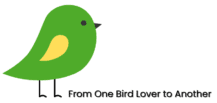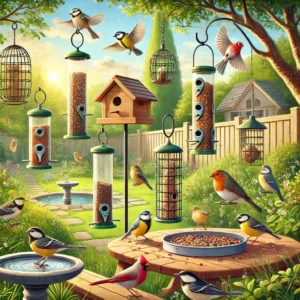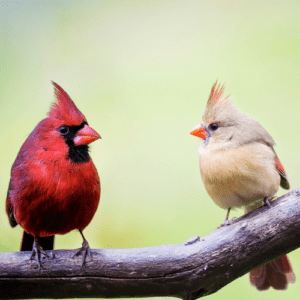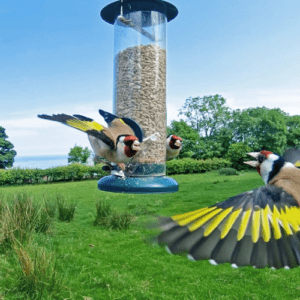Ah, woodpeckers. They’re like the drummers of the bird world—showing up with their wild hairdos (ever seen a pileated woodpecker?) and rhythmic pecking. There’s nothing quite like the sight and sound of one of these birds in your backyard, but how to attract woodpeckers? It took me a while to get it right. After a fair share of trial and error, a little help from the birding community, and some personal tricks, I finally managed to make my yard woodpecker-friendly. So, if you’re ready to invite these winged percussionists into your space, here’s what I’ve learned about how to attract woodpeckers and keep them around.
Step 1: How to Attract Woodpeckers – Feed Them Right!
Let’s talk food. Woodpeckers are like foodies of the bird world—they’re picky but in the best possible way. It took me a while to figure out exactly what would keep them coming back. Here’s what worked:
Suet Cakes: The VIP Ticket
I swear, suet cakes are the golden ticket for woodpeckers. They are high in energy, and woodpeckers seem to find them irresistible. My first suet cake? Gone in a flash. These birds went through it faster than I go through a bag of chips! I now go for suet cakes with nuts and berries mixed in (bonus points for mealworms). And trust me—invest in a suet feeder with a tail prop. Woodpeckers use their tails for balance, and having a little rest makes them more likely to hang around for longer.
Pro tip: Try to grab suet with different flavors. There are even peanut butter ones out there! Switching it up keeps the woodpeckers interested (who knew they could be so picky?).
Peanuts: The Bird Buffet
I still remember tossing out my first batch of unsalted, shelled peanuts and watching the woodpeckers swoop in like it was Thanksgiving dinner. Whole, unsalted peanuts are pure gold for woodpeckers, and the best part is they’ll put on a show cracking them open. Just be warned: you might attract a few extra “guests” (read: squirrels). I like to use a mesh feeder for peanuts, which keeps the squirrels busy while the woodpeckers get their fill.
Black Oil Sunflower Seeds: The Old Faithful
Woodpeckers love black oil sunflower seeds, and so do just about every other bird in the yard. I keep a steady supply of these in a platform feeder, and it’s a surefire way to see some woodpecker action. Just be prepared for some “sharing” because these seeds are like the universal currency of bird feeders.
Step 2: Choose the Right Feeders (Because Not All Feeders Are Created Equal)
In my early bird-feeding days, I naively thought that any feeder would do the trick. I quickly learned that woodpeckers are particular, especially the larger ones. Here’s what I’ve found works best for them:
Suet Feeders with Tail Props
Woodpeckers like to brace themselves while they eat, so a tail prop is essential. After a week of watching them try to eat from my dangling feeder without a prop (it was like watching a ballet gone wrong), I switched to a tail-prop model. It made a world of difference, and now they hang out a lot longer. You’ll thank me later.
Platform Feeders for Bigger Bites
Not all woodpeckers are perch feeders. Some of them, especially red-bellied woodpeckers, don’t mind dining on the ground or on a platform feeder. I keep one stocked with peanuts, sunflower seeds, and dried fruit. Platform feeders also attract other visitors, but that’s just part of the fun.
Mesh Peanut Feeders: The Great Peanut Heist
I’ll admit, I was skeptical about mesh peanut feeders at first. I thought the woodpeckers might not bother with them, but boy, was I wrong! Watching a woodpecker work for its peanut is downright entertaining. I even tried a spiral-style peanut feeder, which was a hit (and hilariously baffled my local squirrel squad).
Step 3: Create a Woodpecker-Friendly Habitat
Alright, this is where things get serious. If you want to know how to attract woodpeckers, you’ll need to think about their natural environment. Woodpeckers are attracted to areas that feel safe and provide plenty of foraging options. Here’s what I learned (and sometimes learned the hard way):
Leave Some Dead Trees (If It’s Safe)
Yes, you heard me right! That old, scraggly tree you’ve been thinking about taking down? Woodpeckers love it. They nest and forage in dead and decaying trees, so leaving one up (as long as it’s not a hazard) can be a magnet for them. I once read that leaving “snags” helps create natural food sources, and it’s true—my woodpecker sightings skyrocketed after I left an old stump standing.
Pro Tip: The more natural cover and foraging spaces you provide, the better your chances of attracting woodpeckers.
Go Native with Trees and Shrubs
Woodpeckers aren’t into “fancy landscaping.” They prefer native trees like oaks, pines, and dogwoods. These trees naturally attract insects, which is basically a snack bar for woodpeckers. I added a few native plants over the years, and it’s like my yard became a wildlife stopover. Bonus: native plants require less upkeep and can withstand local weather better than non-native plants.
Try a Brush Pile for Easy Insect Access
This one was a surprise to me! Turns out, woodpeckers will actually forage in brush piles. After pruning a few shrubs, I left a pile in the corner of the yard, and it became a little bug haven. The woodpeckers took notice, and now I have a “buffet” that takes zero maintenance.
Step 4: Water Features: Because Even Woodpeckers Need a Drink
Water is a crucial attractor for birds, including woodpeckers. I’d always heard about adding birdbaths but didn’t realize the difference it would make until I set one up. Suddenly, I had blue jays, robins, and yes, woodpeckers hanging around the birdbath. I’ve even seen a few of them bathing (which, by the way, is adorable).
If you’re feeling fancy, try a dripper or a small fountain—woodpeckers love the sound of moving water. In the summer, it’s a lifesaver for them, and it adds a nice touch to your yard too.
Step 5: Tackling Squirrel and Raccoon Invasions (Because They WILL Happen)
Alright, let’s get real. Squirrels and raccoons are inevitable when you’re feeding birds. I can’t tell you how many times I’ve looked out the window to see a squirrel halfway up my feeder pole. Here’s what I’ve found works to keep the freeloaders at bay:
Use a Squirrel Baffle
This was a game-changer. A squirrel baffle is a dome or cone that goes on your feeder pole, making it harder (and funnier) for squirrels to reach your feeders. After installing a baffle, I watched one squirrel slide down the pole like he was in an action movie. Worth every penny.
Bring Feeders In at Night
I learned the hard way that raccoons are nocturnal masterminds. They’d clean out my feeders overnight, leaving me with nothing but empty cages by morning. Bringing the feeders inside at dusk keeps them safe and stocked for the next day’s woodpecker visitors.
Hang Feeders from Thin Wire
If you can, hang your feeders from a thin wire strung between trees. Squirrels have trouble balancing on the wire, and it keeps them off the feeders. It took some trial and error to get the tension right, but now I’ve got it down to a science.
The Takeaway: Attracting Woodpeckers Takes Patience—and It’s Totally Worth It
If you’re ready to enjoy the daily woodpecker show, just remember it takes a little patience, a bit of trial and error, and maybe some laughs along the way. If you’re like me, you’ll find yourself watching these birds for hours, appreciating every tap and every peanut they take off with.
So grab some suet, hang up those feeders, and enjoy the sound of a woodpecker drumming in your own backyard. You’ll feel like a pro birdwatcher in no time—and trust me, the woodpeckers will make it worth your while. I hope this guide about how to attract woodpeckers will be helpful to you! Happy woodpecker-watching!




